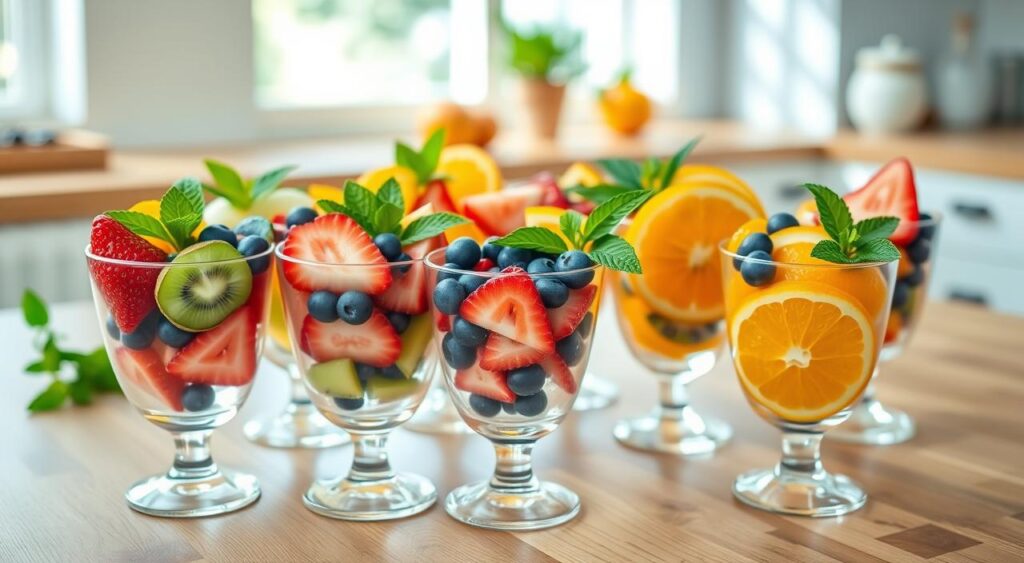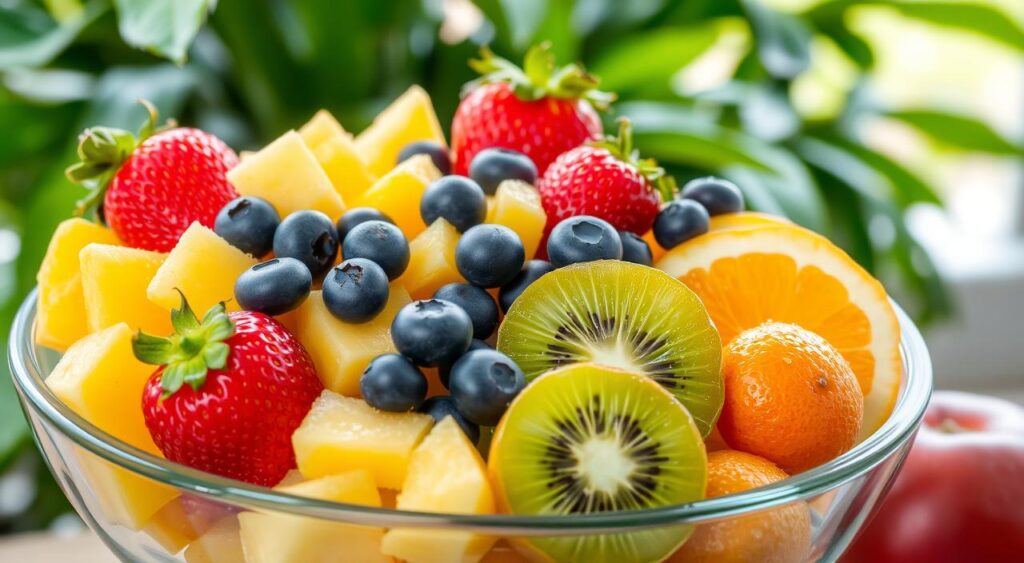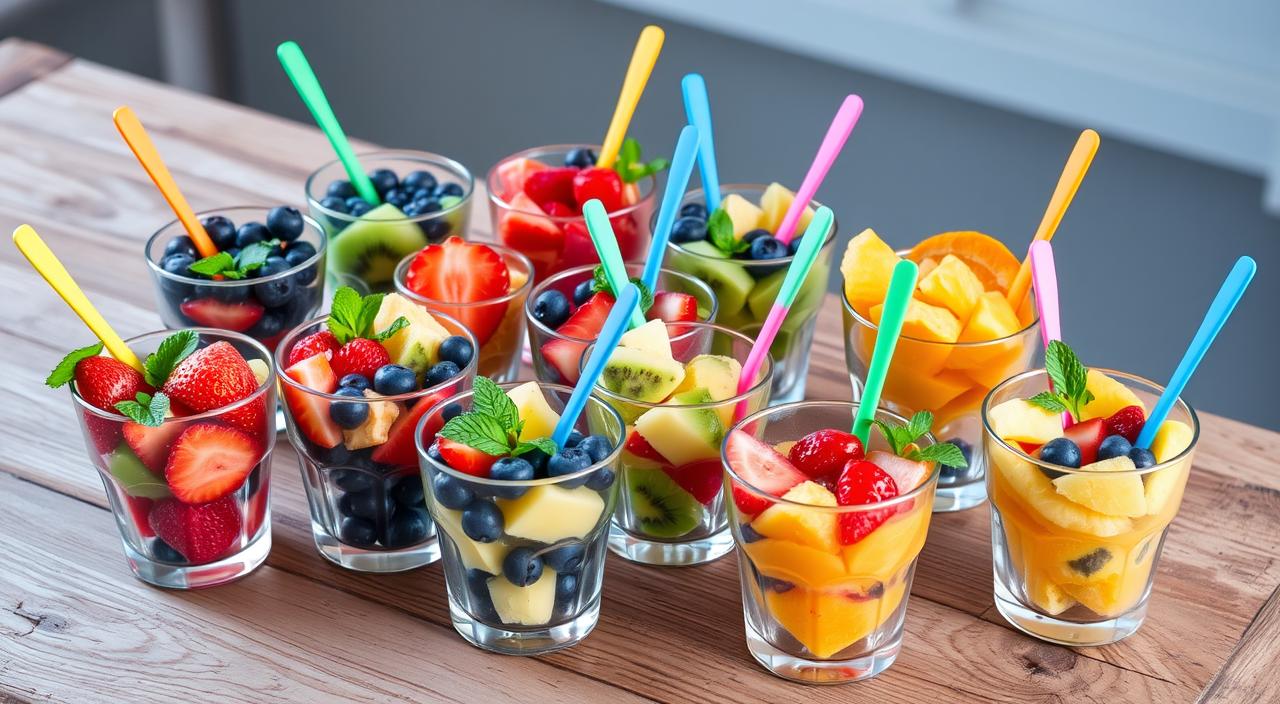As a busy parent, finding healthy snacks for your kids can be tough. But, you can make fresh fruit cups at home. These are not only nutritious but also let you pick the flavors your family likes.
No more sugary store-bought snacks. With a few ingredients and some prep, you can make your own fruit cups. It’s rewarding to pack your child’s lunch with something you made yourself. Fresh fruit cups make snack time better for everyone.
Benefits of Making Homemade Fruit Cups

Making your own fruit cups at home has many benefits. It’s more cost-effective and lets you control what goes into them. Plus, it’s better for the environment because of less packaging.
Cost-Effective Alternative to Store-Bought Options
Buying fruit cups from stores can be expensive. Making them at home saves money, especially when you buy fruits in season. This way, you get a tasty and healthy snack without spending a lot.
Environmental Benefits of Reduced Packaging
Store-bought fruit cups often come in plastic, which harms the environment. Homemade homemade fruit cups use much less packaging. This choice is better for the planet and shows your commitment to sustainability.
Control Over Ingredients and Sugar Content
When you make it at home, you choose what goes in them. This means you can avoid additives and control the sugar content. It’s great for those watching their sugar intake or following certain diets. Making your own fruit cups is a healthier, more cost-effective, and eco-friendly option.
“Homemade fruit cups allow you to savor the natural sweetness of fresh fruits, without the added sugars and preservatives found in many store-bought options.”
Essential Ingredients for Perfect Fruit Cups

Making tasty and pretty fruit cups at home is simple with the right stuff. You need fresh, seasonal fruits and a liquid to keep them fresh and prevent browning. Popular fruits include apples, pears, peaches, cherries, mangoes, grapes, apricots, blueberries, clementines, and strawberries.
For the liquid, choose apple juice, white grape juice, lemonade, or coconut water. It adds sweetness and keeps the fruit fresh. Some recipes add honey or fresh mint for extra flavor and smell.
“The secret to making perfect homemade fruit cups is selecting the ripest and most flavorful fruits, and pairing them with the right preserving liquid to lock in their natural sweetness and vibrant colors.”
By picking the best fruit cup ingredients and fresh fruits, and using the right preserving liquid, you make amazing fruit cups. These healthy snacks are great for any time of day.
Best Fruits for Fresh Fruit Cups
Choosing the right fruits is key to making tasty fruit cups. You can pick from summer fruits or year-round options. Mixing different fruits creates a mix of flavors that’s sure to please.
Summer Fruits Selection
Summer brings juicy and sweet summer fruits. Strawberries, peaches, and cherries are great for adding sweetness. Make sure to remove pits from cherries, apricots, and peaches before adding them.
Year-Round Fruit Options
For fruits you can enjoy all year, try apples, pears, and citrus. These fruits add crunch and a bit of tartness, balancing the sweetness of other fruits.
Combining Fruits for Best Flavor
Mixing fruits is where the magic happens. Pair soft fruits like strawberries with crunchy ones like apples or grapes. This mix of textures and tastes makes your fruit cups even better. Always choose fruits that are perfectly ripe for the best taste.
“Perfectly ripe fruits are the cornerstone of any delectable fruit cup. With the right balance of sweetness and acidity, your creations will become a refreshing delight.” – Olivia, Fruit Cup Connoisseur
Liquid Base Options for Fruit Preservation
Choosing the right liquid base is key for keeping fruit fresh in homemade cups. Apple juice, white grape juice, lemonade, and coconut water are good choices. For less sugar, try mixing half fruit juice with half water.
Some recipes use a honey and mint syrup for flavor. It’s best to pick 100% fruit juice to avoid extra sugars. Make sure the liquid covers the fruit to keep it fresh.
“Fruit canned in juice or sugar syrup will hold its brighter color longer than if canned in plain water, emphasizing the importance of the choice of canning liquid on the appearance of preserved fruit.”
The USDA suggests using Splenda® or stevia for sweeteners in canning liquids. Tests show sucralose is sweet enough at half the sugar amount. But, saccharin or aspartame sweeteners are not good because they lose flavor when heated.
The National Center for Home Food Preservation has guidelines for syrup measurements. For a 9-pint canner batch, you can use from 3/4 cup of sugar to 6 1/2 cups of water. This range goes from extra-light to extra-heavy syrup.
Step-by-Step Preparation Guide
for make it easy at home. First, wash and dry all fruits. Then, peel and core them, cutting into small pieces. Use a fruit protector for apples and pears to stop browning.
Proper Fruit Cutting Techniques
Proper cutting is crucial for fruit preparation. Cut fruits into even sizes for a uniform texture. For soft fruits like berries, gently fold them in to avoid damage.
Assembling the Fruit Cups
Fill containers three-quarters full with cut fruit. This leaves room for a liquid base. Add a mint leaf to each cup before sealing.
Adding Preservation Liquid
Pour your chosen liquid base over the fruit until it’s just covered. Leave a bit of space at the top. Stir gently to coat all fruit evenly.
“Homemade fruit cups can be stored in the fridge for 3-5 days in airtight containers.”
Storage Containers and Equipment
Choosing the right containers is key for storing homemade fruit cups. Airtight containers keep your fruit fresh. Glass jars, like the WeeSprout Mini Glass Jars (4 oz), are durable and eco-friendly.
For easy transport, consider shatterproof containers. The Babymoov Glass Food Storage Containers come in 4 oz and 8 oz sizes. They fit different portion needs.
Plastic containers, like the WeeSprout Leakproof Baby Food Storage, are also a good choice. They are lightweight and easy to carry. Make sure to clean all containers well before use to keep your fruit fresh and safe.
“Proper storage is the key to preserving the freshness and flavor of your homemade fruit cups.”
Look for containers with tight, airtight lids. This keeps the juices in and the fruit moist. Glass and shatterproof containers are great for fridge and lunchbox storage. They let you see your fruit cups.
Get containers in various sizes for different needs. This way, you can store individual servings, family portions, and even party sizes. With the right containers, your fruit cups will stay fresh and delicious for a long time.
Tips for Preventing Fruit from Browning
Keeping your homemade fruit cups looking fresh is important. It makes them more appealing and tasty. To stop browning, try these natural ways.
Natural Prevention Methods
Make sure your fruits are fully covered in a liquid. Acidic juices like lemonade or apple juice work well. They stop the enzyme that causes browning.
For apples and pears, use Fruit-Fresh Produce Protector or lemon juice right after cutting. This helps keep them looking good.
Timing and Temperature Considerations
Make your fruit cups just before you plan to store them. This reduces air exposure, which speeds up browning. Quick chilling or freezing keeps the fruit’s color and texture.
Freezing? Use a power freeze setting for smaller ice crystals. This helps keep the fruit fresh longer.
With these easy tips, your fruit cups will stay vibrant and tasty. A bit of prep work can prevent browning. Enjoy the natural sweetness and health benefits of your homemade snacks.
Creative Fruit Cup Combinations
Try new things with your homemade fruit cups. Mix tropical flavors like mango, pineapple, and kiwi. Or, go for sweet berry mixes with strawberries, blueberries, and raspberries.
For a classic taste, mix apples, pears, and grapes. This combo is both crunchy and juicy.
Use the seasons to your advantage. Enjoy summer with peaches, plums, and cherries. Or, try winter with citrus fruits. Add pomegranate seeds or dragon fruit for a surprise.
Make sure your fruit cups have a good mix of sweet and tart. Try different fruits to find your favorite flavors. A little creativity can turn your fruit cups into a masterpiece.
FAQ
What are the benefits of making homemade fruit cups?
Making your own fruit cups saves money and reduces waste. You also get to choose what goes into them, controlling the sugar content.
What are the essential ingredients needed for making perfect fruit cups?
You’ll need a variety of fresh fruits and a liquid to preserve them. Options include apple juice, white grape juice, lemonade, or coconut water.
What are the best fruits to use for fresh fruit cups?
Summer fruits like strawberries, peaches, and cherries are great. Apples, pears, and citrus fruits are good all year. Blueberries, grapes, and pineapples are also excellent choices.
What are the different liquid base options for preserving the fruit?
You can use apple juice, white grape juice, lemonade, or coconut water. For less sugar, mix half juice with half water.
What is the step-by-step process for preparing homemade fruit cups?
First, wash and dry the fruits. Then, peel and cut them into small pieces. Fill containers 3/4 full with fruit and cover with your chosen liquid.
What types of containers and equipment are best for storing homemade fruit cups?
Glass jars like WeeSprout Mini Glass Jars (4 oz) and shatterproof options are good. Plastic containers like WeeSprout Leakproof Baby Food Storage are also great for their lightness and portability.
How can you prevent the fruit from browning in the homemade fruit cups?
Make sure the fruits are fully covered in liquid. Use acidic juices like lemonade or apple juice. Treat apples and pears with Fruit-Fresh Produce Protector or lemon juice after cutting.
What are some creative fruit cup combinations to try?
Try tropical mixes with mango, pineapple, and kiwi. Berry blends with strawberries, blueberries, and raspberries are also tasty. Classic mixes with apples, pears, and grapes are always a hit. Add pomegranate seeds or dragon fruit for a unique twist.
